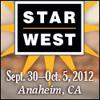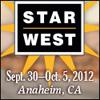 |
Accelerating the Software Development Lifecycle Using Service Virtualization
Video
Remove software and service dependencies enabling continuous integration and testing across the development lifecycle. Stand up test environments faster and at a lower cost accelerating development and test cycles. Balance quality and speed - deliver high quality software faster.
|
Peter Cole, IBM Rational
|
 |
ClouT 3i Infotech's Testing Platform Enterprise
Video
Infotech is a global Information Technology company committed to Empowering Business Transformation. Our Independent Testing and Compliance Business [ITCB] became the world's first true testing platform in 2011 -- ClouT™
|
John Caymans, Hitachi Data Systems
|
|
|
The Software Development Game Adapting your software development tools, practices, and processes can be difficult, even overwhelming. The authors have studied and applied game-like processes and behaviors to help provide structure to software development adaptation. They propose a process strategy called the software development game to help teams who are faced with change.
|
|
 |
Making Agile Work for Government: A Blended Approach As technology development programs represent some of the biggest line items on agency budgets, there should be little surprise that agile development, with its promise of a fast, lightweight, and iterative approach to delivery of value, has caught the attention of officials from across the government space as they seek to improve their programs’ productivity and effectiveness.
|
|
 |
From One Expert to Another: Markus Gärtner Markus Gärtner is a tester and the author of ATDD by Example. In this interview with Zeger van Hese, Markus talks about his new book, the software craftsmanship movement, and “Beyond Testing,” a workshop he’ll be delivering later this year.
|
|
|
|
Performance Testing Earlier in the Software Development Lifecycle Historically, performance testing has been relegated to simply adding a few weeks to the back end of a project to run a series of prescripted tests. The problem with this approach is that issues that performance test engineers uncover late in the project are often too costly to remediate, placing the entire effort at risk. Agile development methodologies can further complicate the issue due to their ever-changing landscape and often a lack of focus on performance testing. Eric Gee shares innovative ideas and techniques on how testers can engage as meaningful partners earlier in the software development lifecycle. Eric explores the benefits of partnering with software engineers in unit testing under load, testing at the component level, and other novel approaches you can use for early performance testing. If you are concerned about finding performance problems late in development, this session is for you.
|
Eric Gee, Raymond James & Associates
|
|
|
Kata: Discover the Art of Practice to Master New Practices Kata is a Japanese word describing detailed, choreographed patterns of movements one masters through practice. Unfortunately, in software development we use the term "practice" very loosely. Tom Perry shares the latest research into how performing deliberate practice-actually practicing a new skill to become proficient-works. As a representative example, Tom explores the techniques you can use to practice and hone your agile team leadership skills. Through individual exercises and collaborative games, learn how to refine and improve your leadership skills. Take back an understanding of what the impact of practicing new skills has on the performance of individuals and teams while you gain hands-on experience with different models of practice. As a bonus, you'll have a set of exercises to form your own deliberate practice for improving your leadership ability.
|
Tom Perry, Visa Inc.
|
|
|
Test-driven Development: It's All about Fluency Test-driven Development (TDD) is more of a skill that requires repeated practice than a book-learning technique-more like learning a foreign language than implementing a precise process. TDD developers must gain fluency in taking a feature requirement, breaking it into microrequirements, turning it into an assertion with a test scenario, translating that scenario into code, and writing the code that will make that test pass. Rather than a lack of knowledge about this practice, it is a lack of fluency that prevents many smart and well-intentioned programmers from practicing TDD in their work. Llewellyn Falco discusses ways you or your developers can build those skills and gain proficiency with TDD. Learn how TDD improves code design and the specifications needed to write good code. Experience the speed improvement that constant feedback creates while enjoying the safety and confidence you get from automated regression testing.
|
Llewellyn Falco, DevelopMentor
|
|
|
Focus on Value First: An Agile Transformation Competency Framework Organizational transformation is difficult work. Many agile transformation efforts begin with lofty goals only to be sabotaged by unrealistic expectations about the depth and complexity of the changes required. Often, resistance to change is ingrained in an organization’s value system and difficult to overcome. Tamara Runyon presents an overview of a new Agile Transformation Competency Framework-a strategic tool for evaluating and guiding your transformation efforts. Evaluating the organization against the dimensions of the framework-collaboration, agile engineering, product management, environment, organizational culture, and distributed teams-results in a transformation plan that avoids setting unachievable expectations. To institutionalize agile values within an organization and lay the foundation for wide-scale adoption, a company must align with these six competency areas.
|
Tamara Runyon, CollabNet
|
|
|
Lean Framework, Agile Principles, and CMMI® Many large software development organizations, which have discovered that they must become more agile to compete, frequently ask Dan Rawsthorne, "What does 'big' scrum look like?" Because no two organizations are alike, this simple question does not have a simple answer. There are, however, some common patterns that emerge in organizations that have implemented "big" scrum. Dan Rawsthorne presents the Product Owner Team pattern that allows the organization to handle agility up and down its hierarchy. Dan discusses cross-cutting teams that handle issues the formal hierarchy can’t properly address-for example, architecture and usability teams. He recommends creating an Integration and Evaluation (I&E) team to provide a natural home for test specialists to perform usability testing, pre-release validation, and performance testing.
|
Dustin Potts, Nationwide Insurance
|

